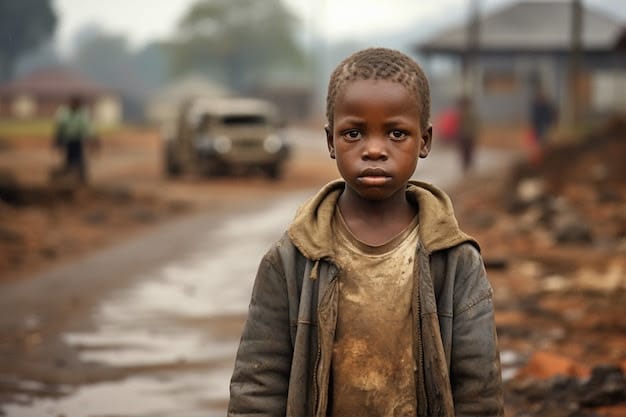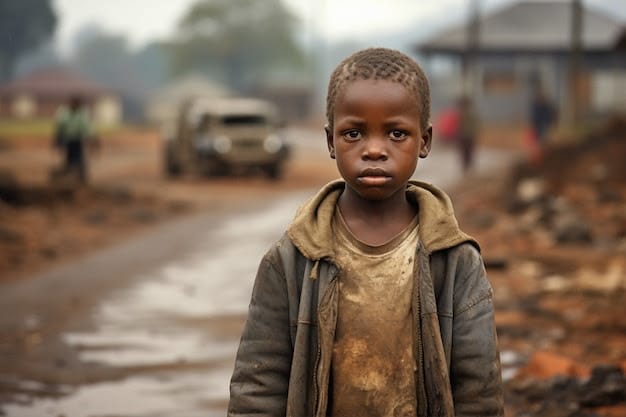
Climate disasters are forcing many families to move around the world. These migrations increase the vulnerability of children, who are particularly exposed to health and social risks.
Children affected by climate disasters
43.1 million (20,000 per day): This is the number of internally displaced children due to climate-related disasters in 44 countries between 2016 and 2021, according to a report published by UNICEF (the United Nations Children’s Fund) in October 2023. The main causes:
Floods and storms, which are responsible for 95% of climate migration;
drought;
fires.
While the Philippines, India and China are the countries most affected by flooding in absolute numbers, small island countries such as Cuba, Dominica (76% of the child population was displaced in six years) or Vanuatu remain the most exposed to storms. Children in Somalia and South Sudan are suffering from both drought and flooding.
UNICEF forecasts are no more reassuring: in the next 30 years, river-related floods alone should cause 96 million children to be displaced, not counting preventive evacuations.

Figures probably underestimated
These figures are certainly underestimated, because slow-moving climate change, such as desertification, sea level rise, land and forest degradation, also have a major impact on living conditions: famines, economic precariousness…
For example, repeated droughts in the Horn of Africa, first affecting livestock and pasture areas, are forcing families to flee from famine.
Some countries that are highly exposed to climate hazards have already put in place measures to protect their populations. UNICEF, for its part, makes recommendations to strengthen the protection of children:

Increase funding for countries most at risk of child displacement due to weather disasters:
Strengthen data systems to plan, track and monitor these movements:
Use new technologies to better predict and simulate natural disasters:
Ensure continuity of essential services for children (education, health, social protection and child welfare):
Educate children about global warming and involve them in the implementation of concrete measures.
Where are the children most affected?
The study’s findings show two very different tables. Three countries dominate the results in terms of absolute numbers:
The Philippines, India and China, which together account for nearly 23 million child weather-related displacements between 2016 and 2021.
Nationally, 9.7 million children were displaced in the Philippines, 6.7 million in India and 6.4 million in China. In addition to their location and geographical profile, which is prone to flooding and storms, the size and density of these countries also help explain these figures.
While these three countries are highly exposed to weather disasters, and may become increasingly vulnerable to the intensifying effects of climate change, all undertake preventive evacuations as a disaster approaches.
When managed properly, these evacuations are an effective way to save lives and mitigate the harm caused by displacement*. Data do not distinguish between preventive evacuations and displacement following a disaster, but it is impossible to determine precisely the proportion of displaced children among the displaced.
Preventive evacuations are more likely to be implemented (and reported) in the event of floods and major storms, such as cyclones, typhoons and hurricanes, as well as in countries with data systems, Early warning and disaster risk reduction.
In relative terms, South Sudan and Somalia recorded the highest number of child displacement due to flooding, a situation that affected almost the equivalent of 12% of the child population for South Sudan, and close to the equivalent of 11% for Somalia.
Both countries have much fewer preventive evacuations in place and reported them, suggesting that children are even more at risk of displacement.
Small island developing states and countries in the Horn of Africa account for the largest proportion of child movements in relation to their infant population. Dominica, Saint Martin (French part), Sint Maarten (Dutch part), the Northern Mariana Islands, Cuba and Vanuatu recorded the highest number of storms-related child displacements in relation to their infant population size.
For example, 76% of the child population in Dominica has been displaced in the last six years and 31% of the child population in Cuba.
These displacements have a significant impact on the management of health care, education and child protection services. Between 2017 and 2021, droughts caused more than 1.3 million internal child displacement across 15 countries.

More than half, 730,000 in Somalia, 340,000 in Ethiopia and 190,000 in Afghanistan. Contrary to the analysis of floods and storms, drought data show that most displacement occurs as a result of the disaster.
Preventive evacuations in these contexts are extremely rare, so it is likely that the majority of these movements were not accompanied by advance warnings or efforts to minimize their effects. However, this analysis has its limitations: displacement due to slow-moving phenomena such as droughts is likely to be largely underestimated. I
There is currently no global estimate of the level of future displacement associated with slow-moving disasters, and previous drought-related displacement data are incomplete.
In addition, these movements are often motivated by a combination of aspirations and socio-economic factors. Drought episodes can intensify resource-related conflicts, reduce economic opportunities and put pressure on public institutions and infrastructure, Not to mention that displacement is generally even more difficult to measure in countries with fragile and conflict situations and/or weak data collection and monitoring capacities.
Finally, analysis of displacement caused by uncontrolled fires shows that weather disasters exacerbated by climate change affect both low- and high-income countries. Uncontrolled fires alone are responsible for 810,000 new child movements, with more than one-third of these occurring in 2020 alone.

Israeli kids seeing each other once again: (Photo: Kobi Kuankas)
The US, Canada and Israel, all of which have strong early warning systems and disaster risk reduction systems, as well as very good data systems, are the countries with the highest number of children displaced, Most of them were used for preventive evacuations.
Looking at the previous trends in travel, several types of countries appear: countries that are highly susceptible to weather disasters – which are likely to increase in frequency and intensity as climate change becomes more severe – but that are taking steps to minimize the risks associated with displacement, and countries with high disaster risks but rarely carrying out preventive evacuations.
The second category is children and communities that are most vulnerable. It is therefore essential to implement risk mitigation, adaptation and preparedness measures in these countries, including preventive evacuations and other climate-related mobility solutions, To save lives and minimize disruptions in access to essential services for children.




